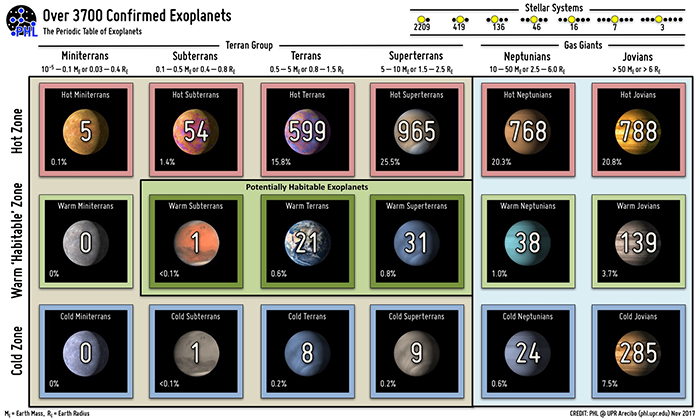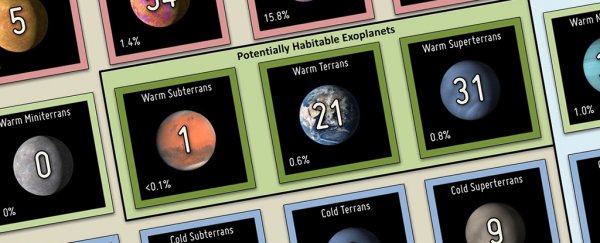With each passing year, we're discovering more exoplanets – planets outside our Solar System – and a team of astronomers has come up with an ingenious way of charting all of the 3,736 exoplanets we know about so far.
It's called the Periodic Table of Exoplanets, and it ranks these thousands of planets in terms of their size, composition, and temperature. Thanks to this categorisation, it gives an at-a-glance view of the worlds most likely to support life.
Astronomer Abel Méndez, director of the University of Puerto Rico's Planetary Habitability Laboratory (PHL), is one of the main architects behind the chart, which is constantly updated as new discoveries are made by our most powerful telescopes.
"We know of over 3,700 planets around other stars," Méndez told George Dvorsky at Gizmodo. "They are very diverse."
"We can roughly classify them by their size and temperature. Only warm planets with the right size, similar to Earth, might provide some of the conditions for extraterrestrial life."
 (PHL)
(PHL)
Down the left of the table, exoplanets are split into cold, warm, and hot zones, based on the distance from their star and thus the temperature on the surface. It's the warm zone where we've got the best chance of finding habitable planets.
Along the top, these exoplanets are categorised based on whether they're rocky (the Terran Group) or gaseous (the Gas Giants) in nature. They're then further split up by how big they are.
In terms of size the chart goes all the way from miniterrans (think the Moon) to Jovians (think Saturn and even bigger).
On each of the panels the total number of exoplanets is listed, together with the percentage of the total – so we can see that 53, or around 1.4 percent of the worlds we know about could potentially harbour life.
Meanwhile, up in the top right, a small chart shows the number of stellar systems we've discovered, grouped by how many exoplanets they contain: so 2,209 of the systems we've found only have one exoplanet that we can detect.
If that wasn't enough work for Méndez and his colleagues at the PHL, they've also taken the time to categorise a further 4,302 candidate exoplanets spotted by the Kepler observatory. More work is needed to confirm whether these are genuine exoplanets.
The Periodic Table has been around for several years and it means that newly discovered exoplanets can quickly be slotted into the overall picture. It also helps researchers focus in on the planets most likely to contain some form of alien life.
At the moment, the hot exoplanets outnumber the cold ones, but that's probably because they're easier to detect by telescope – not necessarily because there's more of them out there.
Meanwhile the delicate work of trying to detect exoplanets goes on. At the moment we can't spot them directly, but we can identify the changes they make to light coming from other stars.
As the number of known exoplanets grows, the Periodic Table will be waiting for them.
"I'm overwhelmed by the number and diversity of planets in the stars around us," Méndez told Gizmodo. "So many places to explore in our own Solar System, but much more is waiting for us beyond."
"I won't be very surprised by another planet with life, Earth is the example that this is possible. I will be more surprised by something we haven't seen before."
You can read more about the Periodic Table of Exoplanets on the PHL website.
